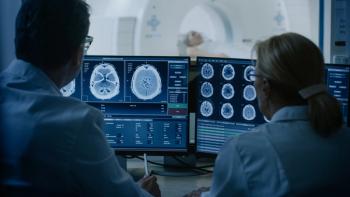
When to Call, When to Counsel: Extrapyramidal Symptoms (EPS)
Key Takeaways
- Extrapyramidal symptoms (EPS) are movement disorders caused by dopamine D₂ receptor-blocking medications, affecting patient quality of life and adherence.
- EPS includes acute syndromes like dystonia, akathisia, and parkinsonism, and chronic conditions like tardive dyskinesia, with varying onset times.
Explore the impact of extrapyramidal symptoms on patients, including drug-induced parkinsonism and dystonia, and the importance of early detection and management.
In pharmacy practice, alerts for extrapyramidal symptoms (EPS) frequently appear during drug utilization reviews (DURs), flagging potential risks. EPS are movement disorders caused primarily by medications that block dopamine D₂ receptors, commonly antipsychotics but also certain antiemetics like metoclopramide.1,4 These side effects are increasingly seen with adjunctive antipsychotics, such as aripiprazole, brexpiprazole, and cariprazine, used to enhance treatment for major depressive disorder (MDD).1,4
EPS encompasses both acute and delayed-onset syndromes. Acute reactions include dystonia, akathisia, and drug-induced parkinsonism, whereas tardive dyskinesia represents a chronic, often persistent condition.5-6 Dystonia manifests as sudden, sometimes painful muscle contractions affecting the head, neck, trunk, or limbs, and typically arises within hours to days of starting or adjusting medication.8 Akathisia involves an inner sense of restlessness accompanied by observable behaviors like pacing, foot tapping, or shifting weight, usually appearing early in therapy.9 Drug-induced parkinsonism presents with tremor, rigidity, slowed movement, masked facial expression, and shuffling gait, generally developing within days to weeks.10-11 Tardive dyskinesia (TD) is delayed in onset, characterized by repetitive involuntary movements, often of the mouth, face, or limbs, typically after months or years of cumulative exposure.
EPS can significantly impact patients’ lives, causing discomfort, swallowing or breathing difficulties, increased fall risk, stigma, and reduced adherence, potentially leading to relapse or hospitalization.5-6,11 Although not rare, EPS occurs more frequently with first-generation antipsychotics (FGAs) than with second-generation antipsychotics (SGAs)(Table 1), with prevalence estimates of akathisia around 11%, parkinsonism about 20%, and acute dystonia 6–7%.8-13 Other medications (Table 2), such as metoclopramide, carry a much lower incidence (approximately 1 in 500 patients).
When to Contact a Prescriber or Refer a Patient
Prescribers should be contacted when patients have one or more risk factors or if they show symptoms of EPS. Patient-related risk factors include a prior history of EPS, older age in females (Parkinsonism and TD), or younger males (dystonia).15 Condition-dependent risk factors also contribute, such as patients living with metabolic syndrome, cardiovascular disease, hypertension, diabetes, kidney issues, immune system disorders, chronic stress, substance use disorder, or mental health conditions. These conditions can increase patients' vulnerability, increasing the risk of EPS. For example, reports have shown that patients with schizophrenia have a very high cumulative risk, over a long period of time, of around 60%. Associated risks are around 30% risk with first-generation and 21% with second-generation antipsychotics.15 Medication-dependent risk factors (Table 3) include medication type, such as first-generation antipsychotics, starting one or more additional medications with similar adverse effects, increasing the dosage of one or more medications, using high doses and more frequent dosing, or switching medications without an appropriate washout period. Medication-related factors include the type of drug (FGA vs SGA), initiating multiple medications with similar side effects, increasing doses, using high doses or frequency, or switching drugs without an adequate washout.
Immediate referral is recommended if a patient reports symptoms such as sudden, painful muscle contractions (dystonia), restlessness and fidgeting or pacing (akathisia), or tremor, rigidity, or slowed movements (drug-induced parkinsonism). These symptoms typically start early, within hours to weeks of new treatment or changes in treatment. Due to the mental health nature of the medication, withdrawal symptoms, and safety concerns for the patient and others, do not recommend stopping the medication, but refer them to speak to their doctor immediately.5-11 If their psychiatrist is unavailable, they can be referred to emergency care for faster evaluation.
Tardive dyskinesia (TD) is a chronic movement disorder that can become irreversible and is associated with prolonged use of dopamine-blocking medications such as brexpiprazole and metoclopramide.1,2 Both clinical evidence and FDA approval documents highlight the importance of monitoring patients on these drugs for early signs of abnormal movements.3,4 While second-generation antipsychotics (SGAs) generally have a lower risk of extrapyramidal side effects compared with first-generation antipsychotics (FGAs), TD continues to be a significant clinical concern.12,13 The emergence of abnormal involuntary movements should prompt communication with the prescriber or referral, as early recognition improves long-term outcomes.5,15 Referral is particularly critical when symptoms progress, interfere with daily function, or compromise adherence to therapy.6,11 Regulatory guidance and prescribing information stress vigilance for tardive syndromes with all dopamine receptor–blocking drugs, including non-antipsychotic agents like metoclopramide, reinforcing the need for timely referral whenever persistent or functionally impairing movements are observed.14
Lastly, emergency referral to the emergency department or hospital can also be needed for patients experiencing EPS. If a patient is having any of the following symptoms or may be experience similar symptoms have them immediately report to the emergency room or nearest hospital: fast or irregular breathing, fever, altered mental status, severe muscle rigidity, difficulty swallowing, involvement of muscles of the mouth, jaw, tongue, throat, larynx, or neck (torticollis), involuntary eye involvements (oculogyric crisis), signs of cardiac involvement or autonomic instability (arrhythmia, hypertension, profuse sweating, or signs of heart attack and stroke).
What Do We Say to a Physician?
When contacting a physician regarding a patient at high risk of developing EPS, provide concise yet thorough information. Start by identifying yourself and the patient, including the prescribed therapy and relevant medical history, especially past EPS. State the interacting medication and why it poses a significant concern. Keep in mind that psychiatric therapy is often multifaceted, and there may be history or extenuating circumstances you are not familiar with. Additionally, the patient may have barriers such as cost, access, and adherence to consider. With that in mind, suggesting alternative therapies or slower, lower-dose adjustments can be helpful. Recommend adjusting therapy by reducing dose, switching to lower-risk agents, or prescribing supportive treatments (eg, propranolol for akathisia, VMAT2 inhibitors for tardive dyskinesia). This will be a sensitive conversation, and psychiatric prescribers may not be accustomed to working with pharmacists collaboratively outside of a hospital setting. Use open-ended questions with the psychiatric prescriber to help gather a more complete picture and enrich your recommendation.
Language for Improved Collaboration with Psychiatric Prescribers
1. Bringing up a patient’s risk of EPS with a prescriber:
- “I’m concerned about the patient’s risk for developing extrapyramidal symptoms with the (addition/increased dose) of X medication. The patient has (A, B, and C) risk factors.Do you feel their risk of experiencing EPS is elevated?
2. Introducing possible alternatives with a prescriber:
- “What are your thoughts on (potentially adjusting the dose, starting at a lower dose or switching to another agent), such as (provide the medication name, dose, and frequency).This medication may have lower risk-factors for EPS.”
- “Do you have other medications or treatment options you prefer for patients who may develop EPS symptoms?”
- “From your experience, what adjustments could we try to avoid EPS in this patient?”
3. Asking a prescriber about continued monitoring:
- “When I counsel the patient on the medication are there any signs or symptoms that I should have the patient watch for?”
- “Do you want the patient to call or make an appointment if they experience non-severe symptoms?
When Do We Counsel a Patient on EPS?
Patients should be counseled about EPS risk before starting new therapy with antipsychotics or other dopamine-blocking drugs and at key transition points during care, such as:
- At initiation of treatment with FGAs or SGAs, including newer adjunctive options like brexpiprazole and cariprazine, which carry documented though differing EPS risks.1-2,5,12
- When adding adjunctive therapy to antidepressants (eg, brexpiprazole or quetiapine XR), as polypharmacy increases risk.1-2,5
- When increasing the dose, higher D2 receptor occupancy is linked to a higher risk.5,8-10
- During long-term therapy, especially beyond 12 weeks.6,11,13
What Do We Counsel the Patient On?
Always start a counseling session by introducing yourself to the patient. Ask the patient, "What did the doctor tell you this medication is for?" This open-ended question will let you know how comfortable a patient is with their mental health condition and what they call their condition. If the patient hesitates or is unsure of the indication, using wording such as "this medication helps with mood" or "works in the brain" is often more palatable and less distressing than the technical term "antipsychotic." Please proceed with the counseling and discuss the medication's name, dosage, and instructions for taking it. When transitioning to the side-effect portion of the discussion, use another open-ended question to gauge what the patient already knows.
"What side effects of the medication are you aware of?" If the patient is not aware of the side effects, use statements such as: "When you take medications that affect chemicals in the brain, it is possible to see changes in muscle movement." Relay that some people may develop movement-related side effects called extrapyramidal symptoms (EPS).1-2,12,14-15 While most patients do not experience serious problems, a small number, roughly 5–15% may notice some changes.12-13 Changes and symptoms you can look for are:
- Sudden, uncomfortable muscle tightness, often in the face, neck, or back (dystonia).8
- A strong feeling of restlessness that may make it hard to sit still or stop pacing (akathisia).9
- Slow movements, stiffness, tremors, or a shuffling way of walking (Parkinsonism).10-11
- Repetitive movements like lip smacking, tongue rolling, or finger motions that usually develop after long-term treatment.6,12-13 This may occur in approximately 1–5% of patients over time (Tardive Dyskinesia).12-13
If you notice any unusual movements, it is essential to contact your prescriber or pharmacist immediately.5,7,9-11 Do not stop your medication suddenly, because abrupt discontinuation can cause withdrawal symptoms, mood changes, suicidal thoughts, and thoughts of self-harm.12
In very rare cases, side effects may require you to visit the emergency room. Again, this is very rare, but watch for changes in breathing, changes in your cardiovascular system, such as high blood pressure, chest pain, palpitations, or signs of stroke. Watch for changes in alertness, awareness, and thinking, such as confusion. If any muscle changes are severe or involve the mouth, jaw, tongue, throat, larynx, neck (torticollis), or eyes, seek emergency medical attention immediately.
Reassure the patient that most people tolerate the medication and that it can be highly effective. Encourage the patient to maintain regular follow-up visits with their healthcare team to detect side effects early and ensure safe and effective treatment.5 Caregivers, family, and friends can also help by noticing changes in movement or behavior so that they can be reported to the prescriber.5
Conclusion
With the growing use of antipsychotics as adjunctive therapy for major depressive disorder—including medications like brexpiprazole and cariprazine—we can expect to see an increase in extrapyramidal symptoms (EPS) in clinical practice.1-2,5,12 While most patients tolerate these medications well, a small percentage may develop movement-related side effects such as dystonia, akathisia, parkinsonism, or tardive dyskinesia.12-13 Early recognition, patient counseling, and timely reporting to prescribers are crucial for preventing persistent complications and maintaining adherence.5,7,9,11 As adjunctive therapy becomes more common in depression management, pharmacists and clinicians will play a critical role in monitoring and preventing EPS.
REFERENCES
1. Otsuka Pharmaceutical Co, Ltd. Rexulti (brexpiprazole) [package insert]. Updated 2025.
2. AstraZeneca. Seroquel XR (quetiapine fumarate extended-release) [package insert]. Updated 2025.
3. US Food and Drug Administration, Center for Drug Evaluation and Research. Brexpiprazole NDA Approval Letter. 2015.
4. US Food and Drug Administration, Center for Drug Evaluation and Research. Quetiapine XR NDA Supplemental Approval Letter. 2009.
5. Gupta S, et al. Extrapyramidal side effects. In: StatPearls [Internet]. Treasure Island, FL: StatPearls Publishing; 2025 Jan.
6. Waln O, Jankovic J. An update on tardive dyskinesia: from phenomenology to treatment. Tremor Other Hyperkinet Mov. 2013;3:tre-03-161-4138-1.
7. Oruch R, Pryme IF, Engelsen BA, Lund A. Neuroleptic malignant syndrome: a review. Basic Clin Pharmacol Toxicol. 2017;120(6):515-519.
8. van Harten PN, Hoek HW, Kahn RS. Acute dystonia induced by drug treatment. BMJ. 1999;319(7210):623-626.
9. Kane JM, Fleischhacker WW, Hansen L, Perlis R, Pikalov A, Assunção-Talbott S. Akathisia: epidemiology, pathophysiology, and management. CNS Drugs. 2009;23(5):401-416.
10. Shin HW, Chung SJ. Drug-induced parkinsonism. J Clin Neurol. 2012;8(1):15-21.
11. Ward KM, Citrome L. Antipsychotic-related movement disorders: drug-induced parkinsonism vs tardive dyskinesia—key differences in pathophysiology and clinical management. Neurol Ther. 2018;7(2):233-248.
12. Carbon M, Kane JM, Leucht S, Correll CU. Tardive dyskinesia risk with second-generation antipsychotics: meta-analysis. PLoS One. 2021;16(6):e0254347.
13. Solmi M, Pigato G, Kane JM, Correll CU. Tardive dyskinesia: prevalence, incidence, and risk factors in antipsychotic-treated patients: a systematic review and meta-analysis. J Clin Psychiatry. 2018;79(2):16r10759.
14. US Food and Drug Administration. Metoclopramide (Reglan) Prescribing Information. Updated 2024.
15. D’Souza RS, Aslam SP, Hooten WM. Extrapyramidal side effects. In: StatPearls [Internet]. Treasure Island, FL: StatPearls Publishing; 2025 Jan. Available from: https://www.ncbi.nlm.nih.gov/books/NBK534115/ . Accessed August 31, 2025.
16. Fusar-Poli P, Meyer-Lindenberg A. Striatal dopamine D2 receptor occupancy and extrapyramidal side-effects: systematic review. Mol Psychiatry. 2023;28(1):151-163.
17. Correll CU, Rubio JM, Kane JM. Risperidone dose, plasma levels, and extrapyramidal symptoms. Front Pharmacol. 2020;11:27.
18. Lisk DR, Pardo CA, Barranger JA, et al. Valproate-induced parkinsonism in the elderly. J Geriatr Psychiatry Neurol. 1994;7(1):46-49.
19. Madhusoodanan S, Alexeenko L, Sanders R, Brenner R. Extrapyramidal symptoms associated with antidepressants—a review. Hum Psychopharmacol. 2010;25(4):281-297.
20. American Psychiatric Association. The American Psychiatric Association Practice Guideline for the Treatment of Patients With Schizophrenia. 3rd ed. Washington, DC: American Psychiatric Association; 2020.
21. Martí-Massó JF, Poza JJ. Cinnarizine- and flunarizine-induced parkinsonism: report of 83 cases. Neurology. 1991;41(10):1664-1668.
22. Citrome L. Valbenazine for tardive dyskinesia: efficacy, tolerability, and place in therapy. Neuropsychiatr Dis Treat. 2017;13:2761-2772.
23. O’Brien CF, Jimenez R, Hauser RA, et al. Deutetrabenazine for tardive dyskinesia: randomized, double-blind, placebo-controlled trial. Am J Psychiatry. 2017;174(5):476-484.
Newsletter
Stay informed on drug updates, treatment guidelines, and pharmacy practice trends—subscribe to Pharmacy Times for weekly clinical insights.


















































































































































































































